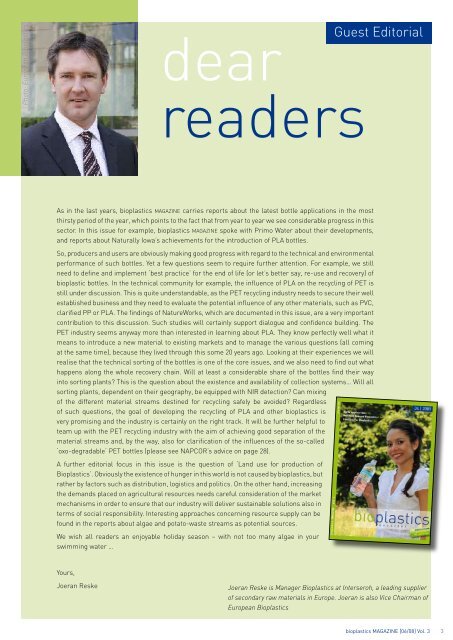bioplasticsMAGAZINE_0904
bioplasticsMAGAZINE_0904
bioplasticsMAGAZINE_0904
Create successful ePaper yourself
Turn your PDF publications into a flip-book with our unique Google optimized e-Paper software.
Photo: European Bioplastics<br />
dear<br />
readers<br />
Guest Editorial<br />
As in the last years, bioplastics MAGAZINE carries reports about the latest bottle applications in the most<br />
thirsty period of the year, which points to the fact that from year to year we see considerable progress in this<br />
sector. In this issue for example, bioplastics MAGAZINE spoke with Primo Water about their developments,<br />
and reports about Naturally Iowa’s achievements for the introduction of PLA bottles.<br />
So, producers and users are obviously making good progress with regard to the technical and environmental<br />
performance of such bottles. Yet a few questions seem to require further attention. For example, we still<br />
need to define and implement ‘best practice’ for the end of life (or let’s better say, re-use and recovery) of<br />
bioplastic bottles. In the technical community for example, the influence of PLA on the recycling of PET is<br />
still under discussion. This is quite understandable, as the PET recycling industry needs to secure their well<br />
established business and they need to evaluate the potential influence of any other materials, such as PVC,<br />
clarified PP or PLA. The findings of NatureWorks, which are documented in this issue, are a very important<br />
contribution to this discussion. Such studies will certainly support dialogue and confidence building. The<br />
PET industry seems anyway more than interested in learning about PLA. They know perfectly well what it<br />
means to introduce a new material to existing markets and to manage the various questions (all coming<br />
at the same time), because they lived through this some 20 years ago. Looking at their experiences we will<br />
realise that the technical sorting of the bottles is one of the core issues, and we also need to find out what<br />
happens along the whole recovery chain. Will at least a considerable share of the bottles find their way<br />
into sorting plants? This is the question about the existence and availability of collection systems… Will all<br />
sorting plants, dependent on their geography, be equipped with NIR detection? Can mixing<br />
of the different material streams destined for recycling safely be avoided? Regardless<br />
of such questions, the goal of developing the recycling of PLA and other bioplastics is<br />
very promising and the industry is certainly on the right track. It will be further helpful to<br />
team up with the PET recycling industry with the aim of achieving good separation of the<br />
material streams and, by the way, also for clarification of the influences of the so-called<br />
‘oxo-degradable’ PET bottles (please see NAPCOR’s advice on page 28).<br />
A further editorial focus in this issue is the question of ‘Land use for production of<br />
Bioplastics’. Obviously the existence of hunger in this world is not caused by bioplastics, but<br />
rather by factors such as distribution, logistics and politics. On the other hand, increasing<br />
the demands placed on agricultural resources needs careful consideration of the market<br />
mechanisms in order to ensure that our industry will deliver sustainable solutions also in<br />
terms of social responsibility. Interesting approaches concerning resource supply can be<br />
found in the reports about algae and potato-waste streams as potential sources.<br />
We wish all readers an enjoyable holiday season – with not too many algae in your<br />
swimming water …<br />
Yours,<br />
Joeran Reske<br />
Joeran Reske is Manager Bioplastics at Interseroh, a leading supplier<br />
of secondary raw materials in Europe. Joeran is also Vice Chairman of<br />
European Bioplastics<br />
bioplastics MAGAZINE [06/08] Vol. 3


















